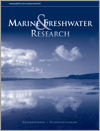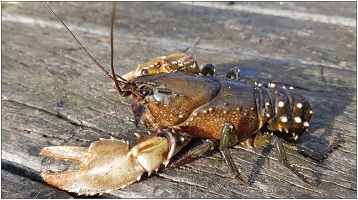Marine and Freshwater Research
Volume 75
Number 7 2024
We collected raw shark fillets from fish markets and takeaway shops across Australia to identify species of shark being sold and the labels used. Our study shows a high level of mislabelling, including misuse of the label ‘flake’ under the Australian Fish Names Standard, and various threatened species being sold. This has implications for consumers and identifies a potential impact of the Australia seafood industry on threatened species.
Fishers often unfurl crayfish tails to determine the presence of eggs. This intrusive practice results in the loss of eggs of fertilised females. Using a crayfish population model, combined with field data, we determined that increasing harvest pressure (capture and handling) of crayfish increased their risk of extinction. Educating fishers to visually assess the sex and reproductive maturity of female crayfish eliminates the need to unfurl crayfish tails, thereby supporting their conservation. (Photograph by Scott M. Raymond)
The carbon dioxide (CO2) concentration of surface seawater was measured from 2008 to 2020 in the south-western tropical Atlantic (SWTA) by volunteer merchant ships equipped with an autonomous system that measures CO2 while the vessels were underway. The study area is influenced by the seasonal variability in the main marine currents of the region, and the tropical meteorological system. The SWTA is as a large source of CO2 to the atmosphere, and further studies in this important area of global climate change are needed.
Aquatic ecosystems are threatened by the introduction of several invasive fishes, for example, the Amazon sailfin catfish that has been reported to successfully invade different freshwaters around the globe, threatening the sustenance of the ecosystem. Here, we developed a specific molecular tool to accurately detect the presence and abundance of the catfish, thus contributing towards management of the aquatic biodiversity.
The Murray–Darling Basin provides critical breeding habitat that supports Australia’s waterbird populations. These birds breed opportunistically, in large rookeries, relying on suitable wetland conditions. We identified 52 wetland sites across the Basin where waterbirds were present in high abundances, 26 of these supported waterbird breeding. Using the breeding and non-breeding wetlands, we identified inundation and vegetation community thresholds associated with waterbird breeding. Understanding habitat requirements can be used in setting conservation targets to ensure waterbird populations are supported into the future.
This article belongs to the collection Environmental flows in northern Murray–Darling Basin: what we know about the science and management after a decade of practice.
This study investigated the survival and movement of Emydura macquarii, Chelodina longicollis and Chelodina expansa in the Gwydir Wetlands of New South Wales. E. macquarii and C. longicollis were tracked using radiotelemetry and our findings suggest that they navigate terrestrially. Freshwater turtles isolated in drier regions of the Murray–Darling Basin are at high risk of mortality in severe drought.
This article belongs to the collection Environmental Flows in Northern Murray–Darling Basin: what we know about the science and management after a decade of practice.






